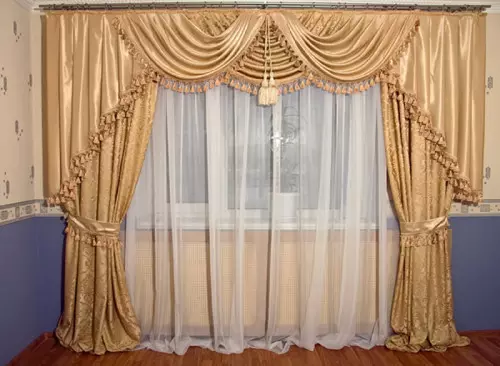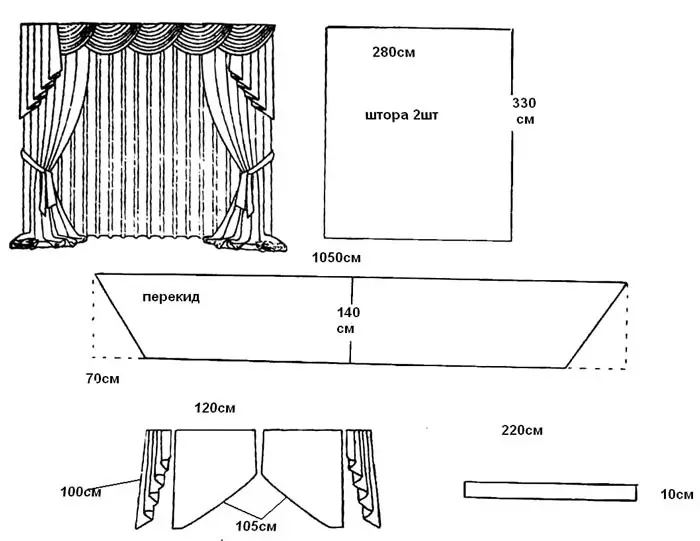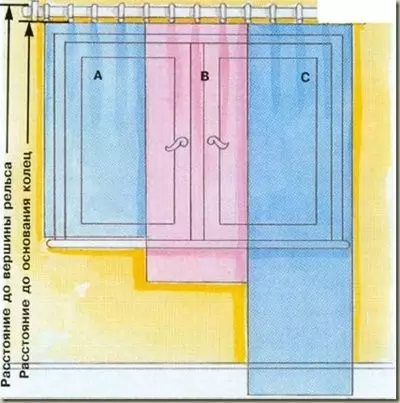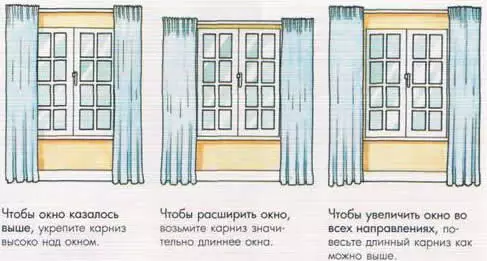Cardina is an important part of the decor designed to bring a note and originality to the interior. That is why the choice of curtains for the window should be primarily focused on compliance with the overall design of the room. Today manufacturers offer a wide variety of products for design windows, but not always the price corresponds to the stated quality. Given this, it should be said that the decision to sew curtains with his own hands looks more than relevant.

Monophonic materials fit into any interior.
It is easy to make it, you only need to follow several rules of work.
What material seven gardines
The word "Gardin" came to the Russian language from Holland, where one of the types of light curtains is called. A similar decor is a cloth of a dense, but light or air and translucent tissue. Gardin can be used as a window decoration or as a bed.Usually, tulle, satin, Muslin, Organza, Mitkal and some other soft and lightweight fabric are used for sewing. The curtains sewn from the presented materials can be highlighted from the window separately or in combination with heavy porters. In this case, the fabric can decorate all sorts of decorative elements - brushes, fringe or flocks.
Usually, the curtains consist of two parts: working fabric and lambrequin - a narrow panel, which closes the place of attachment of the curtain to the eaves. Despite the fact that Lambereken has a clearly pronounced decorative function, many mistresses prefer to use the curtain without it.
Preparation for tailoring Gardin

Pattern for sewing curtains with your own hands.
If you have already decided on the design and know how Gardin will look like, it is necessary to prepare conventional portno accessories, without which the manufacture of a decorative element is impossible. For sewing, you will need:
- cm;
- scissors;
- cloth for curtains;
- threads;
- Curtain tape or curtain tape;
- sewing machine.
Sewing Gardin does not require special skills, and if you choose the cloth and make measurements, then the result will exceed your expectations. Removal of measurements is made as follows:
- The length of the eaves is measured to which Gardin will be attached. In order to create a beautiful wave, add 1/3 to the resulting result, if it is planned to tailoring curtains having a magnificent draper, the result must be multiplied by 2-3 times.
- The distance from the floor to the cornice is measured. For long curtains, the resulting result must be added 10-20 cm.
Article on the topic: Dielectric bots and galoishes
As an example, you can take the following calculations: for an eaves with a length of 3 m with a height of the floor to a cornice, a piece of tissue with dimensions of 9 x 3 m will be required.
In addition, do not forget that the choice of fabric directly depends on the location of the window. Thus, the decor of the window located on the north side can be performed by less dense tissues. For these purposes, Flax, Satin or Atlas will fit well. If the windows are located on the south side, it is desirable to use a dense fabric - velvet, passage, etc.
Features of some types of fabric

Main sizes Curtains: A - to the windowsill; At 15 cm below the windowsill; C - to the floor level.
Each tissue has its own characteristics that determine the complexity of its cutting and tailoring. For example, velvet is very complicated in processing, especially if we are talking about the master who first sewed for the sewing machine. This type of fabric is inherent in such properties as a strong crown with a stripping and tendency to slip when stitching. Given this, when working with velvet, some rules are required:
- Before opening, swipe on the fabric and determine the direction of the pile. Velvet can only be painted on the pile.
- Immediately after cutting, wash the edges of the fabric to eliminate the crown.
- Stooling details, scroll them with pins, and better outtage.
- Ascertaining the fabric, mostly slowly move the panel of the machine.
- When entering the edges, use an involve line so that the threads are not visible from the front side.
If we talk about the atlas or silk, it is difficult to cut the tissue. Due to its smooth structure, the fabric is very sliding, which can lead to an incorrect cut. Before cutting silk or satin, fold it in half, secure the pins, join the folding of the iron, and then cut the desired web.
Article on the topic: Restoration of parquet: old how to restore your own hands, parquet floor, repair and video, what to use the board
Veil and chiffon - transparent and air materials - have a feature to be tightened during sewing. So that this does not happen, use only a typewriter with a fine tissue sewing function.
Algorithm sewing Gardin with his own hands

Location of cornice for curtains.
When the fabrics are purchased and properly prepared, you can start sewing. Typically, the width of the piece of fabric, depending on its type, is 1.2-2.2 m. To calculate the required number of bands, the width of the future curtain is required to split the width of the tissue. Then the resulting number of bands should be multiplied by the length that the curtain will have.
For example:
9 m (Gardina width): 1.5 m (width of the fabric) = 6 strips
6 bands x 3 m (curtain length) = 18 m
For sewing, the curtains will require 18 m material with a roll width of 1.5 m.
The strips are fastened with each other pins, if necessary, mad and spend on a typewriter. In order for the seams to be least noticeable, it is desirable to lay the seam as close as possible to the edge of the piece of fabric. Then the stitched edges must be treated with overlock, which will exclude their sprinkle.
When the cloth is sewn into a single whole, it is necessary to turn the edges. So that Gardin looks beautiful, and the fabric did not stretch, the edges must be obtained 2 times 1.5 cm. If the fabric is very thin and light, the bend can be made minimal, but in any case it should not be less than 0.7-1 cm .
Labreken scheme.
Before shooting the podgiba, scamps them with pins, proceed and endure the iron. This will get the most smooth edges of the curtains. Regardless of the type of fabric, the lower back can be made large - from 5 to 10 cm. Often so that the window decor hangs beautifully, a special cord is inserted into the lower bent. Such a cord may be a thin flexible string or chain.
Article on the topic: We select Accessories for the bathroom (48 photos)
The next stage of work is the mount to the material of the curtain (curtain) tape. The top edge of the fabric is filled with 5 cm on the wrong side, and the ribbon is mounted to the podbib. Then the bending is sweeping on the sewing machine first at the top edge, and then along the bottom. And in that, and in another case, the line should take place in one direction.
To create beautiful waves, you need to pull the ends of the curtain ribbon located inside the poda. When Gardin is collected in drapery, it takes a knot at the ends of the tape. Gardin is ready. It remains only to attach it to the eternity.
Rules sewing lambrequin
The sewing of the lambrequin is carried out similarly to work with the main web curtain. So, first of all, it is necessary to measure the required amount of tissue. Typically, the lambrequin length should be equal to the length of the eaves multiplied by 3. The height of the lambrequin should not exceed 1/5 part of the height of the window opening.
Fabric bands purchased for sewing lambrequin are stitched together, edges are processed by overlock. Lambrequen as well as basic curtains must have drapery. To do this, it is necessary to make the top of the tissue in which the curtain tape is sewn. Then the material is draped and fixed.
For fastening the lambrequin, the window will require a double or even triple cornice. This part of the decor is attached to the first, external beam of the cornice. Curtains are usually attached to the second, and on the third - tulle. If the curtains are made of lightweight fabric, then lambrene is fastened on the outer strip, and on the inner canvas of the material.
Having made curtains with their own hands, you can decorate the interior with an original element created exclusively in the singular. Dense and heavy curtains will create comfort in your room, visually reducing its size, and light air fabrics, on the contrary, will make the room light and extensive. Dare, and all your fantasy will find application in the decoration of your home.
